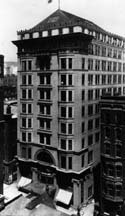Steinway Hall (Chicago)
 |
|
| Former names | Steinway Music Hall, Ziegfeld Hall, Kelly and Leon Opera House, Whitney Opera House, Central Music Hall, Central Theatre, Minturn’s Central Theatre, Barrett’s Central Theatre, Shubert’s Central Theatre, Punch & Judy Theatre, Sonotone Theatre, Studio Theatre, Ziegfeld Theatre, Capri Cinema |
|---|---|
| Location | 64 East Van Buren Street, Chicago, IL |
| Type | Office building / Indoor theater |
| Capacity | 11-stories / 850-seat theater |
Steinway Hall (1896–1970) was an 11-story office building, and ground-floor theater (later cinema), located at 64 E. Van Buren Street, Chicago, IL. The theater had at least 14 different names over the years, opening in 1896 as the Steinway Music Hall, and closing in the late 1960s as Capri Cinema. The building for a time in the early 1900s was the offices and nucleus of a group of famous Chicago architects that included a young Frank Lloyd Wright. These young architects, inspired by the Arts and Crafts Movement and the philosophies of Louis Sullivan, formed what would become known as the Prairie School.
Steinway Hall was an 11-story (then) skyscraper designed by Dwight H. Perkins and opened in 1896. The building was built by the piano makers Steinway & Sons and the theater was one of many Steinway Halls around the world designed to showcase company products.
Beginning in the winter of 1896-97, the building's 11th floor housed the offices of a group of important architects that included Dwight H. Perkins, Robert C. Spencer, Frank Lloyd Wright and Myron Hunt. Wright would maintain an office there until ca. 1908. The building and offices became a central location for architects including Webster Tomlinson, Irving Pond and Allen Bartlitt Pond, Adamo Boari, Walter Burley Griffin and Birch Long. The building served as the nucleus of a group of architects known as The Eighteen, a name coined by Wright to signify a group who gathered for meals to discuss matters of mutual interest. Others outside Steinway Hall who met with the group included Arthur Dean and George Dean, Hugh Garden, Arthur Heun, Alfred Hoyt Granger, Richard E. Schmidt and Howard Shaw.
...
Wikipedia
